Springs (スプリング Supuringu?), also known as Jump Springs (ジャンプバネ Janpu Bane?) and Springboards, are some of the most common gimmicks in Sonic the Hedgehog series. Springs are used to launch the playable characters in different directions, both on the ground and through midair, to reach otherwise unreachable places or built up huge amount of running speed in short time. Springs made the debut appearance in Sonic the Hedgehog (1991) where they were simple red and yellow platforms, but have since taken on a more distinct design over the course of the series.
Description

The original design of the red Spring in Sonic Generations.
In earlier game appearances, Springs are presented as red or yellow panels with a gray-colored spring underneath them. When Springs made debut in 3D games such as Sonic Jam and Sonic Adventure, Springs featured detailed panels of red edges with a gold star in the middle of a blue circle and gray/red springs underneath them. As 3D installments goes on, panels of Springs have also become more rounder in shape with blue/yellow edge lines. Only few games such as Sonic Adventure 2 and Sonic Generations reveals that Springs have pointy ends underneath panels. They can be floating in mid-air with propellers (such as Propeller Springs) or without them. During the series, there have been several other gimmicks based on the Springs.
In earlier installments, red Springs propel the player to a higher elevation, while yellow ones only send the playable character a medium to low distance. Some Springs are hidden underground and will appear when the character moves over them. Springs are usually set on horizontal, vertical or diagonal directions. As the player gets launched to mid-air from vertical and diagonal Springs, horizontal types bounces the player backwards and give extra amount of running speed. Certain sections of the Zone can have pits of Springs or corridors with diagonal pointing Springs. Some Springs can also have floating strings of Rings along the path they send the player.
The player usually has to jump on the Spring to be launched, although they can bounce off Springs by simply touching them in later games. Later, in 3D games, the Springs can also be targeted with a Homing Attack. There are Zones like Spring Yard Zone and Spring Stadium Zone featuring Springs as main gimmicks. Some enemies throughout the series also use Springs to defend themselves.
Game appearances
Sonic the Hedgehog (1991)
Springs first appear in both the 16-bit and 8-bit versions of Sonic the Hedgehog. The game introduced two basic variations of them: Yellow Springs which only bounce the player a small distance into midair, and red Springs which let the player get higher into midair than yellow Springs.
Throughout the game's Zones, the Springs have special roles; in Green Hill Zone some of the Springs are hidden on top of palm trees, while in the Spring Yard Zone they are a part of pseudo-pinball sections. In the Labyrinth Zone, Springs can send the player even higher if the player bounces on them from the water. Star Light Zone also has Seesaws which work like the Spring.
The 8-bit version of Sonic the Hedgehog features both variants of Springs like the 16-bit counterpart. The game also exclusively present three variants of Springs in the game's Special Stages, each which let Sonic bounce a different height: green Springs bounces the highest, yellow Springs medium heights, and purple Springs the lowest of all three.
Sonic the Hedgehog 2

Diagonal type of yellow Spring in Emerald Hill Zone.
In the 16-bit version of Sonic the Hedgehog 2, Springs are aligned both horizontally and vertically. Additionally, the game introduces for the first time diagonally aligned Springs set on the walls which let the player bounce diagonally into the air, and Springs hidden in the ground.
Like in the previous game, many of the game's Zones make their own use of the Springs and their mechanics. When the playable characters exits a transport tube in Chemical Plant Zone, the tube's cover shuts down protrudes and a small red Spring. There are also Catapults and pinball shooters in Casino Night Zone and steam pipes in Metropolis Zone, all of which function similarly to the Springs by sending the player flying through the air. Metropolis Zone also has bumper walls in pits to help the player get out of said pits.
Due to the palette limitations in the 8-bit version of Sonic the Hedgehog 2, the game only has regular Springs which come in multiple colors, such as yellow, green, pink and gray.
SegaSonic the Hedgehog
In SegaSonic the Hedgehog, Icy Isle has pathways where the walls are lined with horizontal orange Springs. If the player touches these Springs, the playable character will bounce back a small distance.
Sonic the Hedgehog CD
In Sonic the Hedgehog CD, horizontally, vertically and diagonally aligned red and yellow Springs appear. In this game, Sonic spins around himself in midair when he bounces on a vertical Spring. Horizontal Springs can also be useful here for time travelling, especially when there are two Springs pointing towards each other. Palmtree Panic and Metallic Madness also feature unique red Springs attached to small wheels which move back and forth, usually on sections with holes in the roofs.
Collision Chaos has arenas of full of vertical Springs, and certain horizontal Springs will pop up from behind to give the player an extra boost of speed on steep ramps. There are even floors in Wacky Workbench that can bounce the player high into the air, an Metallic Madness has crusher pillars the player can bounce on to reach higher levels if they are standing on it. Red Springs (called as Spring Blocks[1]) also appear in several Special Stages.
Sonic Chaos
In Sonic Chaos, vertically aligned yellow and red Springs are usually hidden underground. Only the red Springs are aligned horizontally, though vertically and diagonally aligned Springs appear in the Special Stages as well.
The game introduces the Pogo Spring power-up that equips the player with a movable Spring to bounce with. Enemies like the Bane Motora, Frogger or the Turquoise Hill Zone boss Great Bane Motora Gold also have Springs equipped for their use, usually for defense.
Sonic the Hedgehog 3 & Knuckles
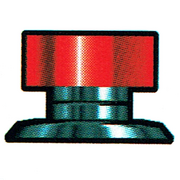
A Spring in the Competition mode of Sonic the Hedgehog 3.
In Sonic the Hedgehog 3, Sonic & Knuckles and Sonic the Hedgehog 3 & Knuckles, yellow and red Springs are horizontally, vertically and diagonally aligned, whereas vertical Springs can be hidden underground or inside breakable obstacles.
In the Gumball Machine version of the Bonus Stages, red Springs on the bottom of the corridor disappear after being used once, but reappear after collecting green Spring Barrier. The Special Stages of Sonic & Knuckles also have yellow spheres which bounces player forward. For the Competition mode, red Springs appear inside floating bubbles along the course. Tagging this item will make a Spring drop onto the course to catapult careless runners off their course.

An merging horizontal Spring in Sonic & Knuckles.
Like in previous games, these titles use the Springs and their mechanics in different way for certain Zones. Marble Garden Zone has the Spiker whose spikes are confusingly capable of bouncing the player like a Spring, while Mushroom Hill Zone's regular mushrooms function like Springs. Flying Battery Zone has some capsules that can the player can bounce on by touching their switch, and as well some pipe hole sections with red Springs that let the player maintain speed when passing through them. Sandopolis Zone has strange-looking stretchy rack between the ground and walls that the player can bounce on as if they were Springs set on walls, and Sky Sanctuary Zone have bouncing clouds whose height of their bounce depends on how fast the player fall on them. Also, one section of Sky Sanctuary Zone has Springs that come out of the ground to bounce the player back down the path; these Springs later reappear in Death Egg Zone.
Sonic Drift series
In Sonic Drift, yellow Springs (called Jump Springs) appear on the racing courses which send the player spinning forward through the air for few seconds, while nullifying any power-up the user may have in effect at the moment. In Sonic Drift 2, these Springs are colored red and are renamed Jump Bane (ジャンプバネ?), but their functions are basically the same as in the previous title. In Sonic Drift 2, there is also the Jump power-up which lets the playable characters launch themselves through the air like the Springs.
Sonic the Hedgehog Triple Trouble
In Sonic the Hedgehog Triple Trouble, vertically aligned yellow and red Springs are almost always hidden underground, while horizontally and diagonally aligned Springs appear normally along with the Pogo Spring power-up.
In addition to the game's normal Zones, Springs also appear in the game's Special Stages. The Sea turtle Badniks in Great Turquoise Zone likewise have Springs on their backs like in Sonic Chaos. Additionally, there is the Flying Spin Attack whic both Sonic and Tails can perform once they get bounced into midair by Springs.
Knuckles' Chaotix

All three colors of Springs in Knuckles' Chaotix.
In Knuckles Chaotix, horizontally, vertically and diagonally aligned Springs are featured regularly. In addition to the red and yellow Springs, this game also presents blue Springs which are more powerful than the red ones. Using Springs in this game can be difficult due the Ring Power, but it is possible to carry the Combi partner to make the usage of them easier.
In the game's Bonus Stages, red and yellow Springs are set on cubic blocks. When the player falls and bounces on these blocks three times, the block becomes broken. The game's Special Stages also feature two different kind of Spring Balls: the Yellow Spring Ball (イエロースプリングボール?), which sends the player forward, and the Green Spring Ball (グリーンスプリングボール?), which sends the player upward.
Tails Adventure
In Tails Adventure, stages such as Poloy's Forest, Cavern Island and Green Island feature blue Springs which the player can use to backtrack in the stage. Tails can also push these Springs along the ground in any direction to determine the location of the bounce.
Sonic 3D Blast
In Sonic 3D Blast, red Springs usually come in two types. The single types are placed under floating Sonic Medals, though the player sometimes must have Flickies to reach some of these medals. The other type of Springs are hidden underground and appear most commonly in Spring Stadium Zone.
Diamond Dust Zone contains rare, horizontal blue Springs on the walls that send Sonic into a roll backwards, and red Springs covered in snow drifts that must be broken to reveal them. In the Sega Saturn version of Sonic 3D Blast, there are pair of red Springs set on half-pipe routes of the Special Stages. Red Springs let the player bounce into the midair to catch Rings or reach higher platform routes.
Sonic Blast
In Sonic Blast, red Springs are notably smaller and appear in both the regular Zones and the Special Stages.
Sonic Jam
In Sonic Jam, Sonic World has two red Springs that sent the player into midair. This is the first game to feature Springs designed with red edges and a gold star in the middle of a blue circle. This design would become the main design for the Springs in future games.
Sonic R
In Sonic R, red Springs are located in Regal Ruin and Reactive Factory to help the player reach the other side of the local pit or climbing the hills.
Sonic Adventure

The Spring's design in Sonic Adventure.

Springs in Sonic Adventure.
In Sonic Adventure and its later iteration Sonic Adventure DX: Director's Cut, the newly redesigned Springs appeared as common gimmicks in the Action Stages. In this game, the Springs only have one design and can shoot the player in any direction, but the player cannot control their movements in midair when they sent them flying, as they manually guide the player to another section.
In addition to the regular Springs, Sonic Adventure introduces the uncommon Wide Spring which is three Springs aligned next to each other, and the Jump Panels which the player can use to sequentially jump from plate to plate.
Sonic Pocket Adventure
Traditional yellow and red Springs reappeared in Sonic the Hedgehog Pocket Adventure where they all are aligned horizontally, vertically and diagonal. Some Spring-based gimmicks from Sonic the Hedgehog 2 appear, including Catapults, pinball shooters and triangular springs.
Sonic Adventure 2

Spring as it appears in Sonic Adventure 2.
In Sonic Adventure 2, Springs look and function similarly to how they did in Sonic Adventure, though their design here also include a blue line along the Springs' edges.
In this game, the player is introduced to another variant of the Spring: the Propeller Springs in Sky Rail. Additionally, there are the Spring Beetle enemies with Springs attached to them which make them virtually invulnerable. By using Mystic Melody, the player can also summon Springs on top of or near Ancient Ruins. In the unlockable Green Hill, Springs have their original sound effect from the original Sonic the Hedgehog when the player bounces on them.
Sonic Advance series
The Springs' design varies slightly between the Sonic Advance games, where they all are aligned either horizontally, vertically or diagonally. In these games, hitting a spring with the Hammer Attack causes the player to be catapulted higher than the Springs are normally capable of. Some games also features Special Springs which let the player enter Special Stages.
Sonic Advance features yellow Springs which cannot launch the player as high up as the red Springs, like in earlier games. However, in Sonic Advance 2 and Sonic Advance 3 only red Springs are featured which can be used by simply running into them. Exclusive to Sonic Advance 2 are dark blue Springs that let the player bounce higher by pressing ![]() and then releasing it as the playable characters jumps. Music Plant also has Hi-hats which work similarly like springs. Exclusively in Sonic Advance 3 are special flatten Springs that only become usable for a short time by pressing a nearby Switch.
and then releasing it as the playable characters jumps. Music Plant also has Hi-hats which work similarly like springs. Exclusively in Sonic Advance 3 are special flatten Springs that only become usable for a short time by pressing a nearby Switch.
In mini-game of Chao Garden in Sonic Advance 2 and Sonic Advance 3, Cream the Rabbit uses Spring on wheels to bounce Cheese for getting enough of Rings from the mid-air while the player is controlling.
Sonic Heroes

A single Spring in Sonic Heroes.
In Sonic Heroes, the Springs reappear once more, albeit with a more bulky design. In this game, regular Springs do not appear as often as Wide Springs due the gameplay involving team mechanic, and are usually found in or locked inside Cases which can be opened after defeating the surrounding enemies.
Shadow the Hedgehog
In Shadow the Hedgehog, Springs are given a redesign to fit the game's dark atmosphere. In this game, Springs are tinted with a darker shade of red and slight rust, and have a green-glowing center. Despite the altered look though, they function just as in Sonic Heroes.
Sonic Rush series
In both Sonic Rush and Sonic Rush Adventure, the Spring is a common and often vital objects. In these games, the Spring is given a slightly rounder shape. They are usually aligned either horizontally, vertically or diagonally, though many of them are mostly set in tight roof corners.
When the player is sent into the air by Springs in these games, the player can perform Trick Actions to gain points and charge the Tension Gauge. Night Carnival in Sonic Rush also features blue Springs, which give automatically 200 points, and Spring blocks, which can be charged by pressing down the D-pad and releasing it at the right time for extra airtime.
Sonic the Hedgehog (2006)

The Spring's design in Sonic the Hedgehog (2006).
In Sonic the Hedgehog (2006), Springs have been given a slightly more detailed appearance, and are normally aligned vertically or diagonally. Like in Sonic Heroes, some of the regular Springs are locked in cases that can be opened after defeating all the enemies around it.
Sonic Rivals series
In both Sonic Rivals and Sonic Rivals 2, the Springs are given a new look, having been redesigned as flat white plates with a red top, a yellow circle in the middle and a blue star at the center. Otherwise, they function like in previous games. All of the Springs are aligned either horizontally, vertically or diagonally.
Sonic Storybook series
In Sonic and the Secret Rings, Springs are usually featured at end of rail sections and walls, where they are given a look befitting the World of the Arabian Nights. Springs along with Wide Springs, also appear at few occasional cases in Sonic and the Black Knight, particularly in the Legacy missions, but are otherwise replaced by blue fairies.
Super Smash Bros. series
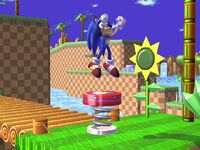
Sonic using a Spring on his special move in Super Smash Bros Brawl.
In Super Smash Bros. Brawl and Super Smash Bros. for Nintendo 3DS and Wii U, the Spring is a part of Sonic's moveset. In these games, the Spring's design mixes the shape of the regular red Springs from early games with their distinct patterns from the 3D games.
When performing Sonic's Up+Special move called Spring Jump, by pressing up and ![]() , a Spring immediately appears underneath Sonic and shoots him up a great vertical distance. When Sonic summons it for himself however, the Spring can also be used by other characters before it disappears.
, a Spring immediately appears underneath Sonic and shoots him up a great vertical distance. When Sonic summons it for himself however, the Spring can also be used by other characters before it disappears.
Sega Superstars Tennis
In Sega Superstars Tennis, Springs can be seen in the background of the Green Hill tennis court.
Sonic Unleashed
In Sonic Unleashed, regular Springs are referred to as Springboards on the Xbox 360/PlayStation 3 version of the game.[2] In this game, the Springs' panel design is more round and has a yellow line around the edge. Certain Springs also have white bases under said panel.
Springs are usually placed to send Sonic to another pathway or section of the stage. The game also introduces several new variants of the regular Spring: Trap Springs which are meant to knock the player off-course, Thorn Springs which can damage the player if they touch it at the wrong time, Springs which float in midair thanks to propellers on their bottom, and blue springs which initiate a quick time event when the player bounces off them.
Two Egg Fighter varieties in the game come equipped with Springs for protection: the Egg Fighter: Knight and Egg Fighter: Shield, each of which wields a shield equipped with a Spring to repel Sonic.
Sonic & Sega All-Stars Racing
In Sonic & Sega All-Stars Racing, Whale Lagoon race course has horizontally placed Springs on the wall. If the racer drives way close to the wall, he/she will be bounced toward the right side of the race track.
Sonic the Hedgehog 4
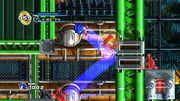
Diagonal Springs in Sonic the Hedgehog 4: Episode I.
In all the episodes of Sonic the Hedgehog 4, the regular red Springs are a commonly featured gimmicks, where they are aligned either horizontally, vertically or diagonally. Like in the 3D games, Sonic is able to target the Springs with the Homing Attack.
In all the episodes, Springs are usually located close to a string of Bubbles line for midair traversing. Like in earlier games, the Springs and their mechanics are also used in different ways in certain Zones: Sylvania Castle Zone features floating platforms in the water sections called Flip Platforms, which the player can use the Homing Attack on to reveal a Spring on their bottom, and White Park Zone Act 2 has Springs that bounce the player between routes that run parallel to each other.
Sonic Colors

A Spring in the Wii version of Sonic Colors.
Springs appear in both the Wii and Nintendo DS versions of Sonic Colors, along with Trap Springs and Wide Springs, which also have a new yellow variant being around in accordance to the player's movements. The Nintendo DS version of the game only features regular red Springs like those in the Sonic Rush games which are aligned either horizontally, vertically or diagonally.
Sonic Generations

A Spring with a white base in Sonic Generations.
In both the console/PC and Nintendo 3DS version of Sonic Generations, the first Act of all the Stages feature only the original yellow and red Springs from the earlier games (with all of their mechanics intact), while the second Act of the Stages only feature the standard modernized Springs from the recent games.
While mostly faithful to their original setting, some of the Springs in the first Act of the Stages are exclusively floating in midair, revealing a pointy head on the bottom. The game also include many Spring-related gimmicks from the entire series, such as Catapults, Wide Springs, Propeller Springs and Trap Springs.
Sonic Jump games

A Spring in Sonic Jump (2012).
In the original Sonic Jump and Sonic Jump 2, vertically pointing Springs come in both the yellow and red variants. However in Sonic Jump (2012) and Sonic Jump Fever, all vertical Springs are red.
Sonic Dash
In Sonic Dash, Springs are used by the player to mark the transition between the sections of the running routes. They are located in rows of three at the end of the routes, with a floating icon above each of them which mark a special feature they grant: Springs with the Ring icon let the player earn Rings while they are sent flying, Springs with the Shuttle loop icon has the player enter a small do-or-die quick time event, Springs with the whale statue icon send the player from the grass route to the stoned bridge of Seaside Hill, and Springs with the totem pole icon brings the player back to the grassy route.
Sonic Lost World

Regular and hidden Springs in Sonic Lost World.
In Sonic Lost World, Springs come in three different types. The regular and medium sized Springs are common gimmicks used for simple transport, and then there are extremely large Springs which are used to move from one section of the Zone to another. The game also has the original yellow and red Springs from the earlier games which are hidden underground or in the walls.
Sonic Runners
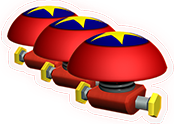
Spring Platforms in Sonic Runners.
In Sonic Runners, Springs come in two types. There are the regular Springs which are larger than normal and aligned either vertically or diagonally, and then there are the Support Springs/Spring Platforms.[3] The latter is a booster-class item that the player can either obtain from an Item Box marked with a Spring icon in the Stages or equip before-handed for 1,000 Rings, which sets up which sets up a string of Springs across bottomless pits to preventing the player from falling into them.
Variants
Catapult
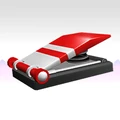
The Catapult in Sonic Runners.
Catapult is variation of Springs, that first appeared in the 16-bit version of Sonic the Hedgehog 2. When running into the catapult, the player is sends flying straight ahead without having to stop.
Pinball Shooter
The Pinball Shooters first appeared in Casino Night Zone in Sonic the Hedgehog 2. For these gimmicks, the player has to hold down the button to load the pinball shooter to launch the player into the pinball sections.
Spring Pole
The Spring Poles first appear in Sonic the Hedgehog CD as minor gimmicks, but became more common objects since Sonic Advance. Spring Poles are flexible bars, usually hanging on walls and the player can launch themselves higher into the air by bouncing on them or gain an extra air boost. Sometimes, the player has to bounce multiple times on them to reach the desired destination.
Pogo Spring
Pogo Spring is a power-up that appeared in Sonic Chaos and Sonic the Hedgehog Triple Trouble. It allows the player to move around with a Spring equipped to the playable character's feet and use it to reach higher levels. Once the player bounces higher and jumps off the Pogo Spring, they will lose it.
Wide Spring

The Wide Spring in the console/PC version of Sonic Generations.
Wide Springs, also known as Long Springs, debuted in Sonic Adventure and have been featured in almost every 3D games since then. As the name says, it features three bumper-based Springs side by side on a panel. Wide Springs are easier to connect with during fast-paced gameplay and bounces the player straight upward.
The Wii version of Sonic Colors later featured a yellow variant of the Wide Spring with three-setter Springs. Like yellow Springs in the first games, these yellow Wide Springs bounces the player less higher than the red ones. After touching it, it starts auto-scrolling to the right and the player usually has to balance on it.
Propeller Spring
The Propeller Spring in Sonic Generations.
The Propeller Springs first debuted in Sonic Adventure 2 and have been later featured in a few current games. Propeller Springs can raise themselves higher into the air if the player continuously uses the Homing Attack on its Spring.
Special Spring
Special Springs appear in both Sonic Advance and Sonic Advance 3. These springs are slightly bigger and used to get to Special Stage. In Sonic Advance they are hidden in one of the Acts in each Zone except for Ice Mountain Zone which have Special Spring hidden in both Acts. In Sonic Advance 3, the player needs to find ten hidden Chao per Zone to unlock the Special Key which will activate the Special Spring and allow entrance to the Special Stage.
Color Panel
The Color Panel is a type of Spring that only appear in two of the Stages in Shadow the Hedgehog. The Data Spring is similar to the regular Spring, but only appear in data worlds, such as Digital Circuit and Mad Matrix.
Blue spring
Blue springs are a variant of Springs that only appear in Sonic Unleashed. They look almost the same as regular Springs, but are blue instead of red. When the player gets bounced of one of these Springs, the player automatically enters a quick time event that must be completed to make the bounce perfect or risk a premature fall.
Trap Spring
Trap Springs are type of Springs that debuted in Sonic Unleashed. Trap Springs have an angular square shape with the Eggmanland symbol on their panel. These Springs are located in place where, should the player hit them, they will bounce the player backwards or off-course. It plays a short, high-pitched laugh after hitting it.
Thorn Spring

A leftover Thorn Spring model from Sonic Colors.
The Thorn Springs are dangerous Springs that first appeared in Sonic and the Secret Rings. These Springs have spikes on their bottom and flip around in intervals. They will thus harm the player should they dare to touch it while their spikes are up.
In other media
Sonic the Comic
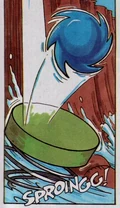
Sonic being bounced by green Spring. Art by Ed Hillyer.
In Sonic the Comic series published by Fleetway Editions, Springs are positioned all around the Mobius and like in games, the user can archive incredible heights by using them. They only appeared in the early stories of the series and are shown with a different color scheme each time.[4] One time, Sonic and Amy used a Hyper-Spring to get to the Floating Island.[5]
Adventures of Sonic the Hedgehog
In the episode Tails Prevails of Adventures of Sonic the Hedgehog, a grey Spring can be seen activated by Doctor Robotnik, who used it to Scratch and Grounder after telling him about Tails having knowledge of machinery. The Spring bounces them to the roof where they get trapped because of the magnet.
Sonic the Hedgehog the Movie

Sonic using a green Spring in Sonic the Hedgehog: The Movie.
In Sonic the Hedgehog: The Movie, a single Spring appears briefly. As Sonic and Tails headed for Robotropolis, Sonic at one point used a green Spring to scale a vertical cliff.
Sonic X
In the anime series Sonic X, a giant Spring with Eggman's face on it appeared in "Chaos Control Freaks" as one of the traps surrounding Dr. Eggman's fortress. Sonic accidentally triggered it when invading Eggman's fortress which sent him miles away.
Trivia
The billboard of "Spring Festival".
- In the world of Sonic the Hedgehog, Springs are not mentioned in the storylines, but they are featured as devices created by humans and has advertising. As an example in City Escape of Sonic Adventure 2, there's a posters which advertise an event, "Spring Festival".
- A leftover model of the Spring from Sonic Jam can be found in data of Sonic Adventure.
- When using the Spring in Sonic the Hedgehog (2006), the character will bounce but the Spring won't move, or doesn't bounce the player but instead repeats its animation.
- In the Adventure mode of Mario and Sonic at the Olympic Winter Games, Sonic has the ability to use Springs, although Mario cannot.
- In an early screenshot of Sonic the Hedgehog (2006), anyone can notice that the concept design of the Spring, is the same as in Sonic Heroes.
- Springs made cameo appearance in Samba De Amigo for the Wii, but they are different looking. The top is made of two parts which are held together by a metal clasp.
- In episode 23 of the Digimon Adventure anime, the sound effect for the regular Spring can be heard, when Digitamamon raises one eyebrow.
See also
References
- ↑ Sonic the Hedgehog CD (Sega CD) North American instruction manual pg. 16.
- ↑ Sonic Unleashed (Xbox 360) North American instruction manual pg. 13.
- ↑ Alternative name used in the game's official website.
- ↑ Sonic the Comic #4, "Day of the Badniks".
- ↑ Sonic the Poster Mag #6, "Marble Garden Menace".
External links
- Spring at the Sonic the Comic Wiki.
